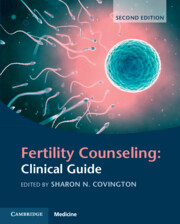Book contents
- Fertility Counseling: Clinical Guide
- Fertility Counseling: Clinical Guide
- Copyright page
- Dedication
- Contents
- Preface
- Contributors
- I Introduction
- II Therapeutic Approaches
- III Third Party Reproduction: Assessment and Preparation
- IV Addressing the Needs of Diverse Populations
- V Special Topics in Fertility Counseling
- Chapter 19 Resilience in Reproductive Loss
- Chapter 20 Reproductive Trauma and PTSD: On the Battlefield of Fertility Counseling
- Chapter 21 Pregnancy Loss Counseling
- Chapter 22 “A Little Bit Pregnant”: Counseling for Recurrent Pregnancy Loss
- Chapter 23 Pregnancy and Postpartum Adjustment in Fertility Counseling
- Chapter 24 Walking the Tightrope: The Pregnant Fertility Counselor
- VI Practice Issues
- The International Glossary on Infertility and Fertility Care, 2017
- Index
- References
Chapter 24 - Walking the Tightrope: The Pregnant Fertility Counselor
from V - Special Topics in Fertility Counseling
Published online by Cambridge University Press: 24 November 2022
- Fertility Counseling: Clinical Guide
- Fertility Counseling: Clinical Guide
- Copyright page
- Dedication
- Contents
- Preface
- Contributors
- I Introduction
- II Therapeutic Approaches
- III Third Party Reproduction: Assessment and Preparation
- IV Addressing the Needs of Diverse Populations
- V Special Topics in Fertility Counseling
- Chapter 19 Resilience in Reproductive Loss
- Chapter 20 Reproductive Trauma and PTSD: On the Battlefield of Fertility Counseling
- Chapter 21 Pregnancy Loss Counseling
- Chapter 22 “A Little Bit Pregnant”: Counseling for Recurrent Pregnancy Loss
- Chapter 23 Pregnancy and Postpartum Adjustment in Fertility Counseling
- Chapter 24 Walking the Tightrope: The Pregnant Fertility Counselor
- VI Practice Issues
- The International Glossary on Infertility and Fertility Care, 2017
- Index
- References
Summary
Counseling patients through their journey to conceive can be challenging. When a therapist becomes pregnant, the therapeutic alliance alters.This chapter explores the unique dynamics between the pregnant fertility counselor and reproductive clients. Questions around the “who, what, where, when, why and how” of pregnancy disclosure are used as a tool to help think about the various elements to the therapeutic alliance. Intense feelings can be triggered for a patient who is struggling with infertility or pregnancy loss, but can also trigger emotional reactions for the fertility counselor. The transference and countertransference that arises with the self-disclosure of a pregnancy is likely to unfold complicated dynamics and emotions. The positive and negative implications that a pregnancy disclosure can have from the patient’s point of view, as well as that of the therapist, are addressed. Additionally, the postpartum experience and the return back to work after parental leave are also discussed. While this chapter focuses on the pregnant therapist, the issues raised pertain to all pregnant reproductive medical staff treating infertility patients.
Keywords
- Type
- Chapter
- Information
- Fertility Counseling: Clinical Guide , pp. 245 - 254Publisher: Cambridge University PressPrint publication year: 2022

